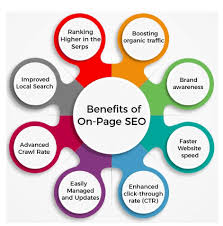Optimizing Your Website: Techniques to Boost Performance
In today’s digital age, having a well-optimized website is crucial for attracting and retaining visitors. Website optimization involves improving various aspects of your site to enhance user experience, increase loading speed, and boost search engine rankings. By implementing the following techniques, you can optimize your website for maximum performance:
Mobile Responsiveness:
With the increasing use of mobile devices, ensuring that your website is responsive and mobile-friendly is essential. Responsive design allows your site to adapt to different screen sizes, providing a seamless user experience across all devices.
Image Optimization:
Large image files can slow down your website’s loading speed. By optimizing images through compression and resizing, you can improve loading times without compromising image quality.
Minify CSS and JavaScript:
Minifying CSS and JavaScript files involves removing unnecessary characters such as spaces and comments to reduce file size. This optimization technique can significantly improve page load times.
Utilize Browser Caching:
Browser caching allows certain elements of your website to be stored locally on a user’s device, reducing the need to re-download them on subsequent visits. This can lead to faster loading times for returning visitors.
Optimize Meta Tags:
Meta tags play a crucial role in search engine optimization (SEO). By optimizing meta titles and descriptions with relevant keywords, you can improve your site’s visibility in search engine results pages.
Implement Accelerated Mobile Pages (AMP):
AMP is an open-source initiative that aims to create faster-loading web pages for mobile users. By implementing AMP on your site, you can provide a lightning-fast browsing experience for mobile visitors.
Monitor Site Performance:
Regularly monitoring your website’s performance using tools like Google PageSpeed Insights or GTmetrix can help identify areas for improvement. By analyzing performance metrics, you can make informed decisions to further optimize your site.
In conclusion, website optimization is an ongoing process that requires attention to detail and continuous improvement. By implementing these techniques and staying informed about the latest trends in web development, you can ensure that your website delivers an exceptional user experience while achieving optimal performance.
Top 5 FAQs About Website Optimization Techniques and Their Benefits
- What is website optimization and why is it important?
- How can mobile responsiveness improve website performance?
- What are the benefits of image optimization for a website?
- What tools can be used to minify CSS and JavaScript files?
- How does browser caching contribute to faster website loading times?
What is website optimization and why is it important?
Website optimization refers to the process of improving various aspects of a website to enhance its performance and user experience. It involves implementing techniques such as mobile responsiveness, image optimization, minifying CSS and JavaScript, and optimizing meta tags to boost loading speed, search engine rankings, and overall functionality. Website optimization is crucial because it directly impacts user engagement, conversion rates, and search engine visibility. A well-optimized website not only provides a seamless browsing experience for visitors but also helps businesses attract more traffic, generate leads, and ultimately achieve their online goals efficiently. By prioritizing website optimization, businesses can stay competitive in the digital landscape and continuously improve their online presence.
How can mobile responsiveness improve website performance?
Mobile responsiveness plays a crucial role in enhancing website performance by ensuring that the site functions seamlessly across various devices, including smartphones and tablets. With the increasing use of mobile devices for browsing the internet, having a mobile-responsive website is essential for attracting and retaining visitors. By optimizing your site for mobile users, you can improve user experience, reduce bounce rates, and increase engagement. Mobile responsiveness also contributes to better search engine rankings, as search engines like Google prioritize mobile-friendly websites in their results. Ultimately, by implementing mobile responsiveness, you can enhance website performance, reach a wider audience, and stay ahead in the competitive online landscape.
What are the benefits of image optimization for a website?
Image optimization offers numerous benefits for a website. By reducing the file size of images through compression and resizing, image optimization can significantly improve the loading speed of web pages. Faster loading times not only enhance user experience but also contribute to lower bounce rates and higher engagement levels. Additionally, optimized images help in reducing bandwidth usage, making the website more cost-effective to operate. From an SEO perspective, properly optimized images can improve search engine rankings and increase visibility in image search results, driving more organic traffic to the website. Overall, image optimization plays a crucial role in enhancing website performance, user satisfaction, and overall online presence.
What tools can be used to minify CSS and JavaScript files?
When it comes to optimizing CSS and JavaScript files, there are several tools available to help minify them effectively. Popular tools such as UglifyJS, YUI Compressor, and Google’s Closure Compiler are commonly used for minifying JavaScript files. These tools work by removing unnecessary characters and whitespace from the code, reducing file size without altering functionality. For CSS minification, tools like CSSNano, Clean-CSS, and Online CSS Minifier are widely utilized to compress stylesheets by removing redundant code and optimizing selectors. By incorporating these tools into your web development workflow, you can enhance website performance by reducing file sizes and improving loading speeds.
How does browser caching contribute to faster website loading times?
Browser caching plays a crucial role in improving website loading times by storing certain elements of a website locally on a user’s device. When a visitor accesses a website that utilizes browser caching, elements such as images, CSS files, and JavaScript are downloaded and stored in the user’s browser cache. This means that on subsequent visits to the same website, the browser can retrieve these cached elements locally rather than re-downloading them from the server. As a result, browser caching reduces the amount of data that needs to be transferred between the server and the user’s device, leading to faster loading times and a smoother browsing experience for visitors.

